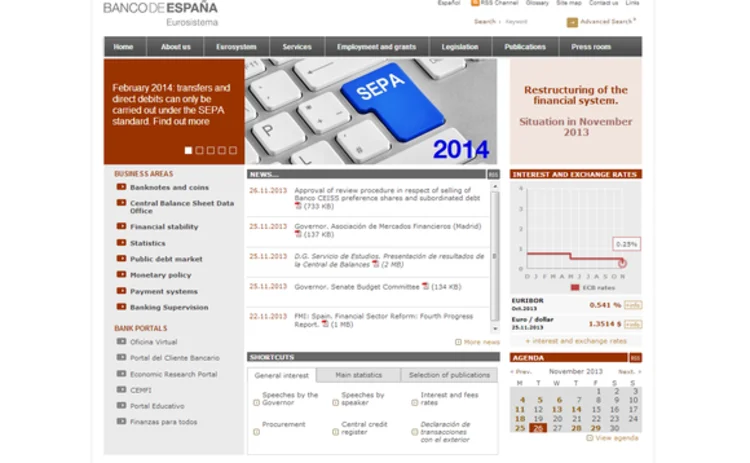
Website of the year: Bank of Spain

Websites act as a vital information hub where citizens and banking professionals alike can find out how their central bank works. The best central banks provide a wealth of information covering the central bank's past decisions, present conflicts and future expectations - often in multiple languages.
If a website is to be successful by allowing its users to access the information they require, it must produce information that is easy to find and simple to digest. Central banking can be very complex, so communicating in a manner that is easily understood by the general public can prove challenging.
Luis M Linde, the Bank of Spain governor, said that "a user-friendly website - where information is readily accessible both to the general public and to specific target groups - is a key tool in broadening awareness of our role as central bankers and supervisors".
One of the main strengths of the Bank of Spain's website is its account of the central bank's basic functions and role within the wider financial system - it strikes a good balance between providing detailed and digestible content.
Some central banks are prone to overwhelm their users with extensive lists of news, dates and data. Others bury information in hard-to-reach places. The Bank of Spain, however, makes information readily available on its website, without forcing it on the user.
The homepage is, first and foremost, clean. It is divided into a selection of neatly distinguished navigational tools. There is an interactive graph highlighting current and recent interest rates, short summaries of the latest news and a plethora of links.
This is a theme throughout the website; the Bank of Spain does not just throw words at its users. Each webpage presents the essential information on a topic and no more, alongside a host of well-organised links.
Víctor M Márquez, the Bank of Spain's director of communications, is fully aware of the difficulties involved in creating a website that addresses the different interests and levels of knowledge about central banking among an audience.
The public needs reliable and understandable guidance; the media demands an active news section; while analysts require a deep and flexible statistical database. This amounts to a staggeringly large quantity of information - the Bank of Spain's website features 7,000 pages of information and 24,700 separate files. But the minimalistic design of the website makes it easier for every kind of user to find what they want.
The Bank of Spain's homepage features links to information on each of the central bank's different functions. When users click on a function, they are presented with a simple, well-phrased definition in either Spanish or English.
While many central bank websites handle more than one language - the National Bank of Tajikistan and the Central Bank of Turkmenistan both communicate in three languages - few do so as well as the Bank of Spain.
Committing to posting in multiple languages is one thing, but mastering the nuances of them is another challenge altogether. The Bank of Spain excels in this regard, as little appears to be ‘lost in translation'.
Alongside each definition the website invites the user to read more about that particular function, the legislation governing it, or relevant publications the Bank of Spain has produced. Crucially, the user is never presented with a mass of information to trawl through.
"We make an effort to provide an introduction to every section and edit the contents to promote easy comprehension," Márquez says. "We wanted to avoid subordinating the contents to a particular graphic design or producing a clash between the look and feel [of the website] and the architecture of information."
This layout is consistent across every one of the Bank of Spain's functions. This in itself is rare, as central banks will often put a lot of thought into how they convey some pieces of information while neglecting others. Information surrounding payments, for example, is notoriously poorly presented.
One of the major upgrades to the website in the past year was the creation of a new section of the website entitled ‘Restructuring the Financial System'. It provides constant updates on the range of measures being adopted to bolster the system in the wake of the financial crisis. Before it was set up, this information was scattered across different parts of the internet, making it difficult to track.
This change was part of an ongoing overhaul to the website that was started in 2009. Since then, the central bank has completed 900 separate projects to improve every element of users' experience.
Another new development in the past year is the introduction of a new web content management system, which has allowed the central bank to offer an RSS service - which provides its users with updates as soon as new information is published - for the first time.
On an aesthetic level, the Bank of Spain has also worked hard to introduce new graphs and organograms to convey its information - including a pioneering interactive organisation chart. These additions highlight the Bank of Spain's forensic approach to meeting the website users' needs.
Before it began revamping the website, an internal team at the Bank of Spain interviewed professional users and the general public to gauge what the necessary changes would be.
The team found demand for a full English version of the website, a more useful homepage, understandable content and a website architecture that was easier to navigate. It is no coincidence that, five years on, these are the areas in which the Bank of Spain's website excels.
Marquez said the central bank is proud of its "demand-driven approach" to maintaining and updating the website, and the "consistency" between the graphic design and the content.
During the overhaul process, Marquez explained, the different users of the Bank of Spain's statistics also called for improvement. The website's extensive database now features a tool that simplifies the process of selecting, viewing and comparing different data series.
The service, dubbed the ‘time series search engine', is similar to the Federal Reserve Bank of St Louis' excellent sub-site on Economic Research, which includes a widely-used and well-presented database of Federal Reserve Economic Data (Fred).
Communication is increasingly becoming entwined with policy at central banks, and it is important they continue to refine the way they interact with the public.
However, before experimenting with new technologies, it is crucial that central banks master the fundamentals. That means developing more detailed and easier to use websites. The Bank of Spain has done just that.
Only users who have a paid subscription or are part of a corporate subscription are able to print or copy content.
To access these options, along with all other subscription benefits, please contact info@centralbanking.com or view our subscription options here: subscriptions.centralbanking.com/subscribe
You are currently unable to print this content. Please contact info@centralbanking.com to find out more.
You are currently unable to copy this content. Please contact info@centralbanking.com to find out more.
Copyright Infopro Digital Limited. All rights reserved.
As outlined in our terms and conditions, https://www.infopro-digital.com/terms-and-conditions/subscriptions/ (point 2.4), printing is limited to a single copy.
If you would like to purchase additional rights please email info@centralbanking.com test test test
Copyright Infopro Digital Limited. All rights reserved.
You may share this content using our article tools. As outlined in our terms and conditions, https://www.infopro-digital.com/terms-and-conditions/subscriptions/ (clause 2.4), an Authorised User may only make one copy of the materials for their own personal use. You must also comply with the restrictions in clause 2.5.
If you would like to purchase additional rights please email info@centralbanking.com test test test





